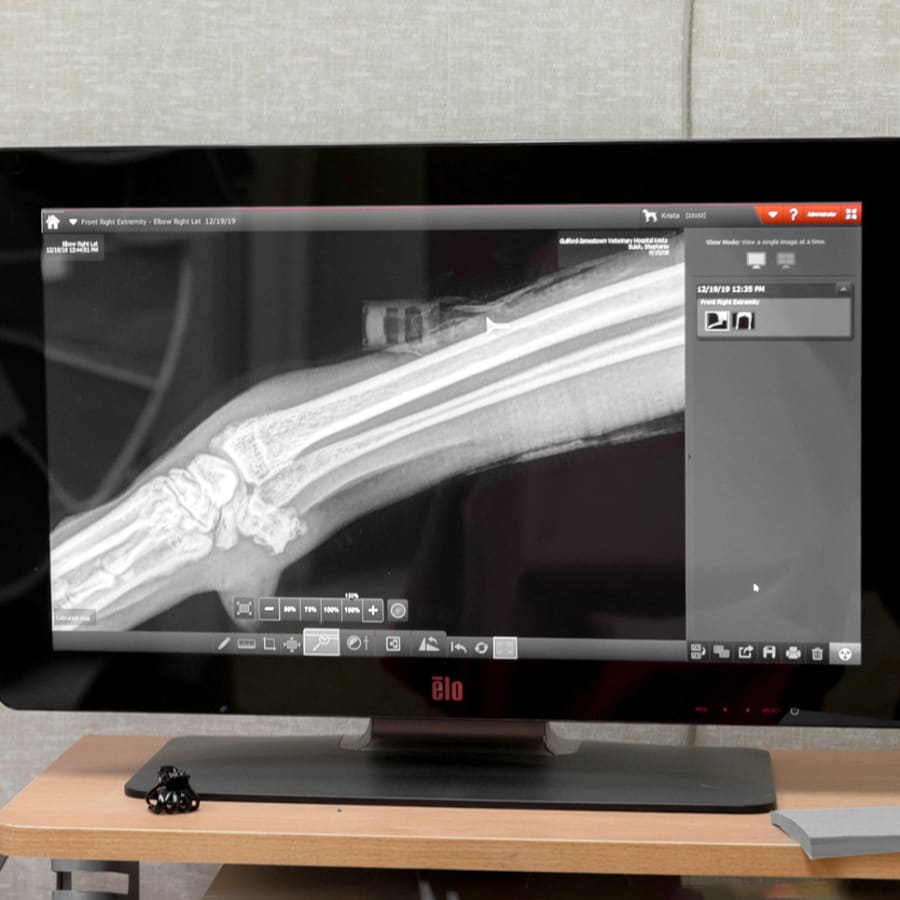Veterinary Diagnostic Lab
We use electromagnetic radiation and other technologies for diagnostic imaging. This allows us to produce highly detailed images of your pet's internal structures.
We have advanced tools at Western Veterinary Hospital to help accurately diagnose your pet's medical issues. From digital radiology to ultrasound and a standing CT Machine, we provide a wide range of services.
With our diagnostic imaging capabilities, we can efficiently produce accurate diagnostic information about your pet's condition and provide immediate treatment options.

In-House Lab & Veterinary Pharmacy in San Angelo
We perform tests and get results quickly in our in-house laboratory so that we can diagnose your pet's symptoms and begin treatment as soon as possible.
Our pet pharmacy in San Angelo is stocked with a range of prescription diets and medications, providing us with quick access to any medications your pet may need while in our care.

Vet Diagnostic Services
With our in-house veterinary diagnostics lab, we offer advanced diagnostic testing to allow our vets to provide an accurate diagnosis of your dog's, cat's, or horse's medical issues.
- Radiography (Digital X-rays)
Using a radiograph (digital x-ray), we can examine your pet or horse's internal systems to reveal information that may be invisible from the outside.
Radiography is safe, painless, and non-invasive. It uses only very low doses of radiation. Because the level of radiation exposure required to perform radiography is very low, even pregnant females and very young animals can undergo this procedure.
Radiographs can be used to evaluate bones and organs, and diagnose conditions including broken bones, chronic arthritis, bladder stones, spinal cord diseases, and some tumors.
- Ultrasound
The use of diagnostic imaging allows our team of veterinary professionals to create extremely detailed images of your pet or horse's internal structures.
With ultrasound imaging, we expose part of the body to high-frequency sound waves to produce images of the inside of the body.
Because we capture ultrasound images in real-time, we can see the structure and movement of your animal's internal organs, as well as blood flowing through the blood vessels.
Having this valuable technology available to our vets in our in-house lab means that your dog. cat or horse's condition can be diagnosed quickly and treatment can start sooner.
- CT Scans
CT (computed tomography) Scans combine X-Ray images and computer technology to help us identify and diagnose numerous diseases and disorders in your animal's body. They have become an essential imaging tool used in veterinary medicine.
Equine-Specific Diagnostics
- Dynamic Upper Airway Endoscopy
Dynamic endoscopy is a method of analyzing upper airway problems during exercise.
Horses are allowed to exercise in their natural environment, and the results of the rest can be viewed immediately after the test is complete. It can also be reviewed in slow motion for a better assessment of the airway function
- MRI
Magnetic Resonance Imaging (MRI) uses a powerful magnetic field, a computer, and radio waves to provide your veterinarian with high-resolution, detailed images of your horse's soft tissues such as the brain, spinal cord, ligaments, tendons, and abdominal organs.
When it comes to many soft tissue injuries or diseases, veterinary MRI often provides a more detailed picture of your horse's body than other diagnostic imaging tools are able to provide.
Our vets can then examine these images on a computer monitor or print them.
Some conditions that MRI can help to diagnose and treat include spinal tissues such as tumors, herniated discs or stenosis; brain tumors and inflammation; strokes; musculoskeletal diseases and injuries including cranial cruciate ligament injuries; and abdominal conditions including organ enlargement or tumors.
- Coggins Testing
A Coggins test is a blood test identifying if a horse is a carrier of Equine Infectious Anemia, a viral disease found in horses. A negative Coggins test is required for all travel between states and at most equine facilities.
- Lameness Locator
A Lameness Locator is a wireless motion analysis system that employs sensors to detect gait asymmetries that aren't visible to the naked eye.
A portable computer wirelessly tracks motion sensors placed on a horse's poll, pasterns, and pelvis to help evaluate its lameness. The sensors are light, weigh less than 30 grams each, and have no bearing on the evaluation. The technology can detect subtle, difficult, or multiple lamenesses, as well as quantify all types of lameness.
The sensors' data can reveal the location of asymmetry in the gait, the severity of lameness, and how stable or unstable the horse's stance appears.
- Standing CT Scans
CT (computed tomography) Scans combine X-Ray images and computer technology to help us identify and diagnose numerous diseases and disorders in your animal's body. They have become an essential imaging tool used in veterinary medicine.
Our CT scanner is able to be used on horses while they are standing - and is one of the few devices of its kind in the country!
New Patients Welcome
Western Veterinary Hospital is accepting new patients! Our experienced vets are passionate about the health of San Angelo companion animals. Get in touch today to book your pet's first appointment.
